THE E-MU MODULAR
Other Modules
E-mu Modular Technical Information |
AdditionalInformation |
E-mu Modular System 2017 |
|
Main Page |
1977 Modular Brochure |
E-mu Modular System Keyboard |
|
Voltage Controlled Oscillators |
- > Other Modules |
More Modular Pictures |
E-mu Modular System Modules |
Voltage Controlled Amplifiers |
Modular Cabinets |
Rossum Interview |
E-mu Modular System Inside |
Voltage Controlled Filters |
E-mu SSM Board |
E-mu Modular System Sounds |
Click on a section above to go to a specific area about the E-MU Modular.
E-MUTHE Eµ SYNTHESIZER SYSTEM |
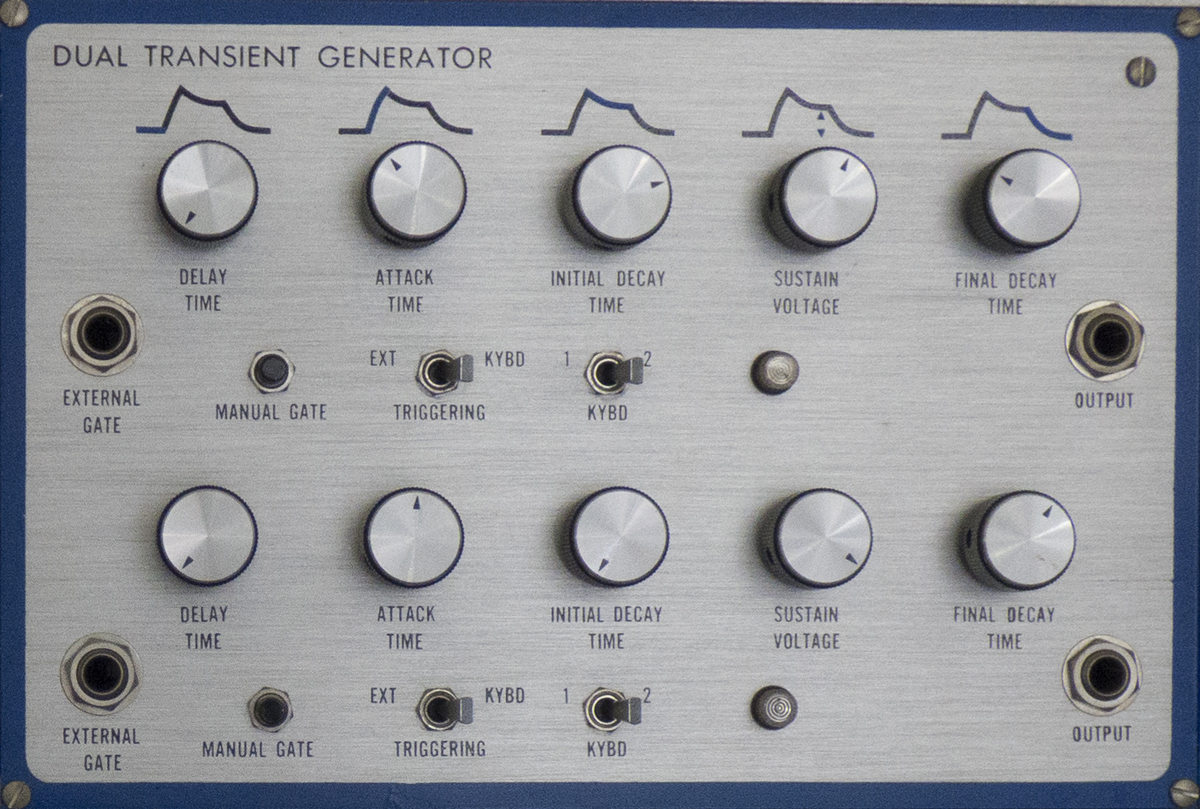 |
Eµ MODULE 2350 - DUAL DELAYED TRANSIENT GENERATORThe Eµ 2350 Dual Delayed Transient Generator module contains two independent four-phase electronic music transient generators in a single module. It is based on two Eµ 1350 submodules. With the triggering switch in the external position, the module will produce a four-phase transient when triggered by an external gate: The time constants for the four independent phases, and the sustain voltage, are determined by the settings of the appropriate controls. In the keyboard mode, the module will similarly respond to the depression of a key (producing simultaneous gate and trigger) with a delay, attack, initial decay, and final decay. Should an additional key be depressed before the first is released, a new attack will begin after the delay time has elapsed. When all keys are released, final decay phase always begins, and no further attacks will occur. If the delay function is not desired, the delay control should be set fully counterclockwise. KEYBOARD FUNCTION: The manual gate acts in the same manner as an external gate input, allowing the user to conveniently determine the effect of a particular transient generator section within a complex patch. The attack, initial decay, and final decay contours are all exponential functions in time, whose time constants are variable over a wide range. The controls vary the time constants exponentially, resulting in remarkably smooth and accurate control over the entire range. The standard control range for the time constants is 1 millisecond to 10 seconds (3 msec to 3 seconds on delay), but the range can be expanded or reduced on request. The gate lamp indicates the presence of a high level (logic "l") on the gate input. Power Requirements: ±15 V @ 30 mA typical +5 V @ 20 mA typical Firm-wire Patch Connections: External Gate Inputs (2) Outputs (2-3 pins each) Power Bus Connected Inputs: Keyboards 1 & 2 Gate & Trigger Adjustments: None
|
Eµ MODULE 2340 - VOLTAGE CONTROLLED LAG PROCESSORThe Eµ 2340 Voltage Controlled Lag Processor is a control voltage processing module using an Eµ 1340 submodule. With the shape control set to "linear", the module acts as a slew limiter. Whenever the input level changes at a rate faster than the appropriate rate control setting, the output slew rate is limited to that maximum slew rate. Highest accuracy is achieved in this mode, sufficient to use this module for voltage controlled keyboard portamento. In the exponential mode, the module acts as a filter with time constant determined by the rate control settings. In this mode it can act as an attack/release transient generator with voltage controlled time constants. The up and down rates are independently exponentially voltage controllable from 0.3 to 3000 Volts/second. The initial rate controls set the center rates; the control inputs are attenuable and vary the rates at a maximum sensitivity of 2V/decade. TYPICAL FUNCTION: (fast up rate, slow down rate): [PIC]
Power Requirements: ±15 V @ 20 mA typical
Firm-wire Patch Connections: Inputs: Signal Input Rate Inputs (2) Output (3 pins)
Power Bus Connected Inputs: None
Adjustments: Up Offset Down Offset |
Eµ MODULE 2355 - VOLTAGE CONTROLLED TRANSIENT GENERATOR INPUT UNITThe Eµ 2355 Voltage Controlled Transient Generator Input Unit module allows wide range voltage control of all parameters on the Eµ 2350 Dual Transient Generator module. The 2355 is connected to the 2350 it controls by an internal ribbon cable. A single 2355 may be wired to control either the upper or lower section of a 2350, or both sections at once. All five inputs are attenuable, and sum with the initial control settings on the 2350 section. The time inputs have a maximum sensitivity of 2V/decade; the sustain voltage input has a maximum sensitivity of unity gain.
Power Requirements: None Firm-wire Patch Connections: 5 Inputs
Power Bus Connected Inputs: None Adjustments: None |
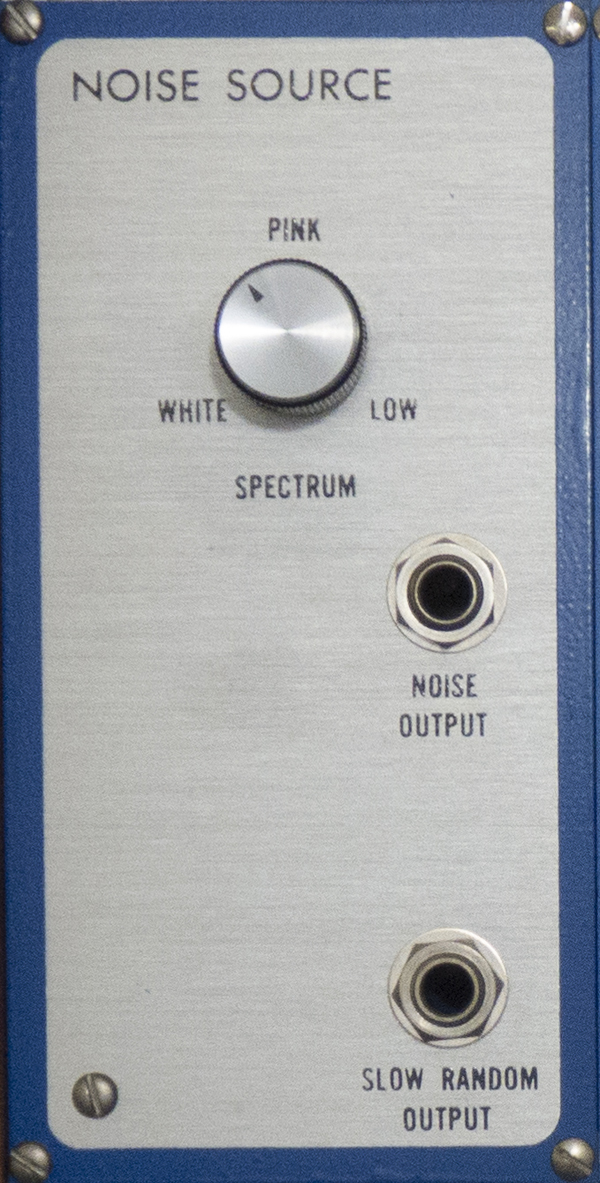 |
Eµ MODULE 2400 - NOISE SOURCEThe Eµ 2400 Noise Source produces random audio and control signals for use in electronic music. It contains an Eµ 1400 noise source submodule. The spectrum control varies the energy distribution of the audio output from white through pink to low filtered noise, by increasing the filtering on the original white noise signal from zero to 6 dB per octave. The slow random output gives a slowly varying control signal , whose energy is maximized in the range from 1 to 10 Hz. Due to the very low frequencies processed by this output, it will not become totally random for several seconds after power is applied.
Power Requirements: ±15 V @ 10 mA typical Firm-wire Patch Connections: Inputs - None Outputs - Noise (3 pins) Slow Random (3 pins) Power Bus Connected Inputs None Adjustments: None |
Eµ MODULE 2410 - SAMPLE AND HOLDThe Eµ 2410 Sample & Hold module acts as an analog memory for synthesizer signals. It contains an Eµ 1410 sample and hold submodule. On application of a fast rising edge (such as a pulse waveform) to the AC sample input, the output of the module will instantly slew to the voltage present at the signal input, and remain at that voltage until another sample command is applied. On application of a positive voltage (>2.5V) to the DC sample input, the output will assume the voltage at the signal input, and track that voltage while the DC sample input remains high. When the sample input goes low, the output will remain at the signal voltage present at that time. The sample pushbutton on the panel behaves as a DC sample input, causing the output to track the input when depressed, and hold when released. Power Requirements: ±15 V @ 15 mA typical
Firm-wire Patch Connections: Inputs - Signal AC Sample Outputs - One (3 pins) Power Bus Connected Inputs: None Adjustments: None
Note: Use of the AC Sample firmwire patch input may interfere with external patches using the DC sample only. This can be remedied by the use of a dummy patch cord in the AC Sample input. |
Eµ MODULE 2420 - DUAL PREAMPThe Eµ 2420 Dual Preamp is a dual variable gain preamplifier for use in interfacing external signals to the modular synthesizer system. It is not intended to replace studio preamps for other purposes. The two amplifiers are completely independent. The gain range is selected by the gain switch, and the desired level accurately adjusted by the attenuator. The gain switch calibrations refer to the amplification factor with the attenuator fully clockwise. The module uses an Eµ 1420 High Gain Amplifier submodule.
Power Requirements: ±15 V @ 20 mA typical Firm-wire Patch Connections: Outputs (3 pins each) Power Bus Connected Inputs: None Adjustments: None |
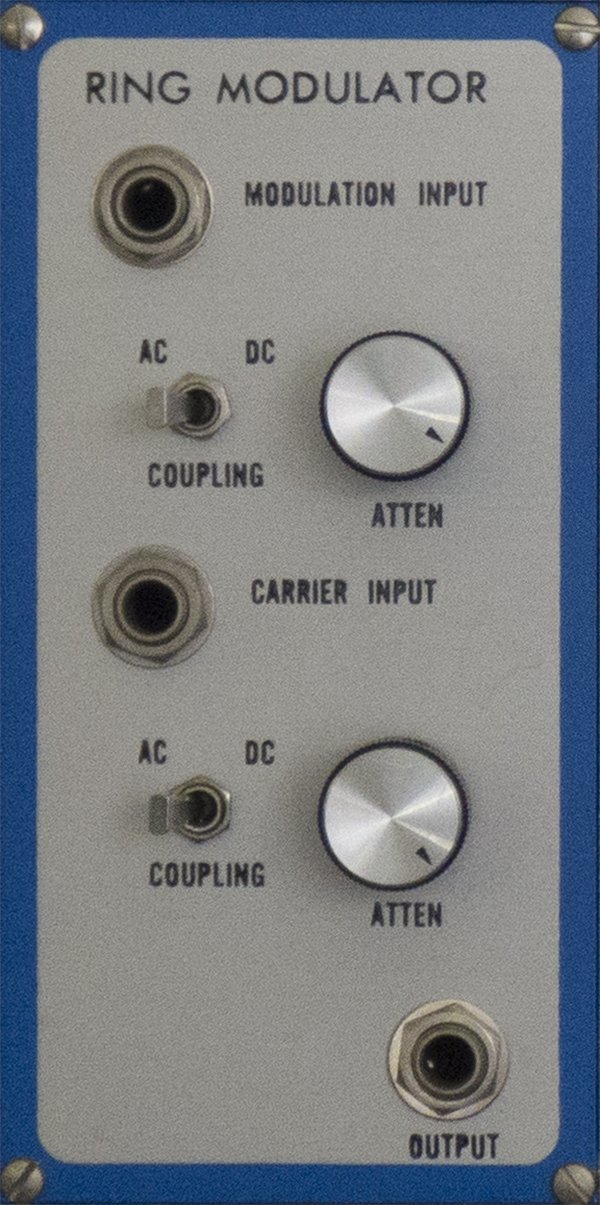 |
Eµ MODULE 2430 - RING MODULATORThe Eµ 2430 Ring Modulator is a balanced modulator for electronic music. It contains an Eµ 1430 ring modulator submodule. The module has two inputs, modulation and carrier, which are identical for high signal levels. The output is the algebraic product of the input voltages: Vout = Vmod x Vcar ÷ 5 when the input attenuators are fully clockwise and the coupling switches are in the DC position. AC coupling will level-shift the corresponding input so it effectively centers around zero volts. This can have a striking effect on the output signal, due to the inherent non-linearity of balanced modulation. The Eµ 2430 was designed for high carrier rejection in the absence of a modulation signal, typically in excess of 80dB. The reverse rejection, that of modulation feedthrough with no carrier, is only 40dB.
Power Requirements: ±15 V @ 10 mA typical
Firm-wire Patch Connections: Inputs - Modulation, Carrier Outputs One (3 pins) Power Bus Connected Inputs: None Adjustments: Gain Modulation Rej'n - Mod positive Modulation Rej'n - Mod negative |
Eµ MODULE 2440 - ENVELOPE FOLLOWERThe Eµ 2440 Envelope Follower module is a conventional envelope detection circuit with slope and level comparators to derive trigger and gate signals. It contains an Eµ 1440 submodule. The input signal is AC coupled and its envelope subsequently detected. The envelope output is filtered such that signal frequencies as low as 50 Hz can be followed without serious ripple. The comparator input is internally pre-wired to the envelope output. At each rapid rise on its input, the trigger section of the comparator will produce a narrow pulse at the trigger output. The slope required to produce a trigger is adjusted by the trigger sensitivity control. When fully counterclockwise, triggering is inhibited. Whenever the DC comparator input level exceeds the sum of the gate threshold control (range O-lOV) and the external threshold input, the gate output rises to +5 volts. The comparator section of the 2440 may be used independently of the envelope follower section by patching the signal to be compared into the external comparator input. Functions such as external pulse generation and modulation, and cyclic transient triggering may be accomplished in this manner.
Power Requirements: ±15 V @ 25 mA typical Firm-wire Patch Connections: Signal Input Envelope Output (3 pins) Gate Output (3 pins) Trigger Output (3 pins) Power Bus Connected Inputs: None Adjustments: None |
Eµ MODULE 2450 - QUAD INVERTERThe Eµ 2450 Quad Inverter is an array of four independent analog signal inverters. The output of the inverter is the inverse about 0 volts of the input signal. Thus a voltage V at the input gives -V out, and sine waves are put 180° out of phase. The inverters are pre-patched to the power supplies to serve as voltage sources when other inputs are not patched. The voltage next to each output jack is the voltage that will appear there when no patch cord is applied to the corresponding input.
Power Requirements: ±15 V @ 15 mA typical
Firm-wire Patch Connections: None Power Bus Connected Inputs: None Adjustments: None |
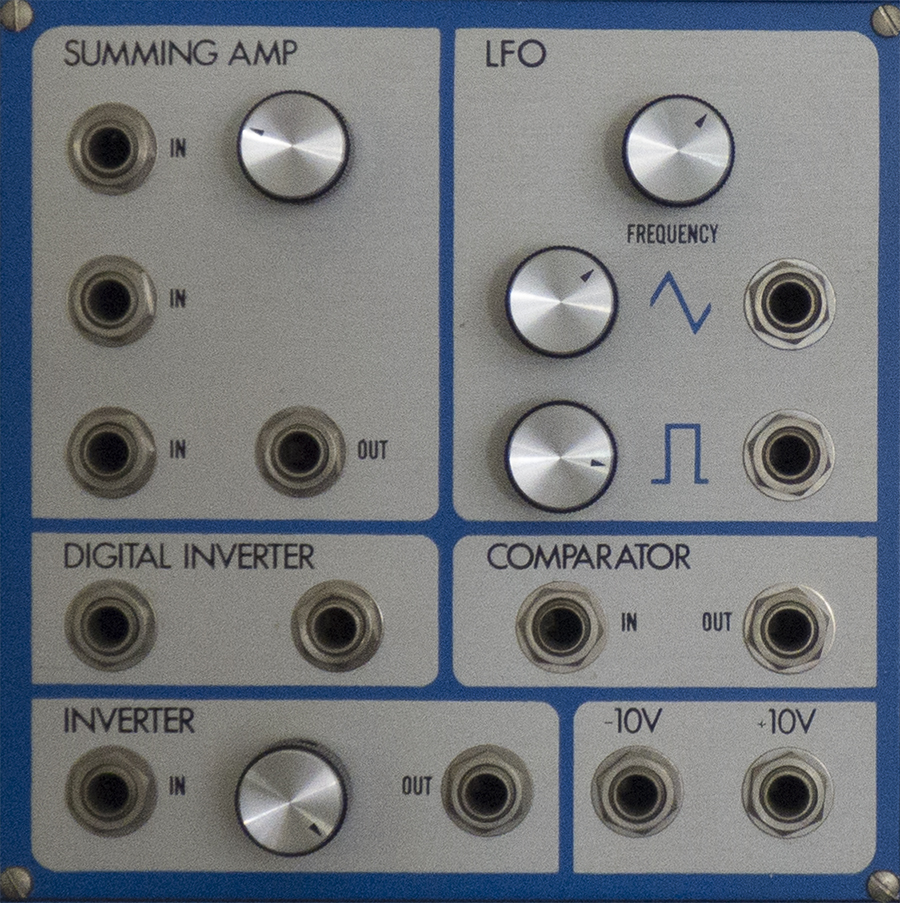 |
Eµ MODULE 2451 - POTPOURRIThe Eµ 2451 Potpourri Module is a multipurpose module designed to add a variety of useful functions to small or medium sized modular systems. The output voltage of the Summing Amp is precisely the sum of the upper input voltage as attenuated by the adjacent control, plus the voltages at the second and third input jacks. The Digital Inverter produces a logic "O" (low impedance to ground) if the input voltage is greater than 3.5 volts, and produces a logic "1" (l.OK? to +5 volts) if the input is less than 1.5 volts. Thus the output is the logical inversion of the input. The output voltage of the Inverter section is the negative (+1 volt in gives -l volt out) of the input, as attenuated by the adjacent control. The LFO is a low frequency oscillator giving triangle and square wave outputs with amplitudes adjustable by the adjacent controls. The oscillation frequency is adjustable from 0.02 to 50 Hz. The Comparator produces a digital output that will be a logic "1" if the input voltage is greater than 0.25 volts, and a logic "0" for inputs below 0.1 volts. Some hysteresis is provided to prevent oscillation even on very slowly changing inputs. The +lOV and -lOV jacks give these voltages with an impedance of l.OK.
Power Requirements: ±15 V @ 40 mA typical +5 V @ 11 mA typical
Firm-wire Patch Connections: Inputs - Summing Amp Atten'd Summing Amp Unatten'd Outputs - Summing Amp (3 pins) LFO Triangle (3 pins) LFO Square (3 pins) Power Bus Connected Inputs: None Adjustments: None |
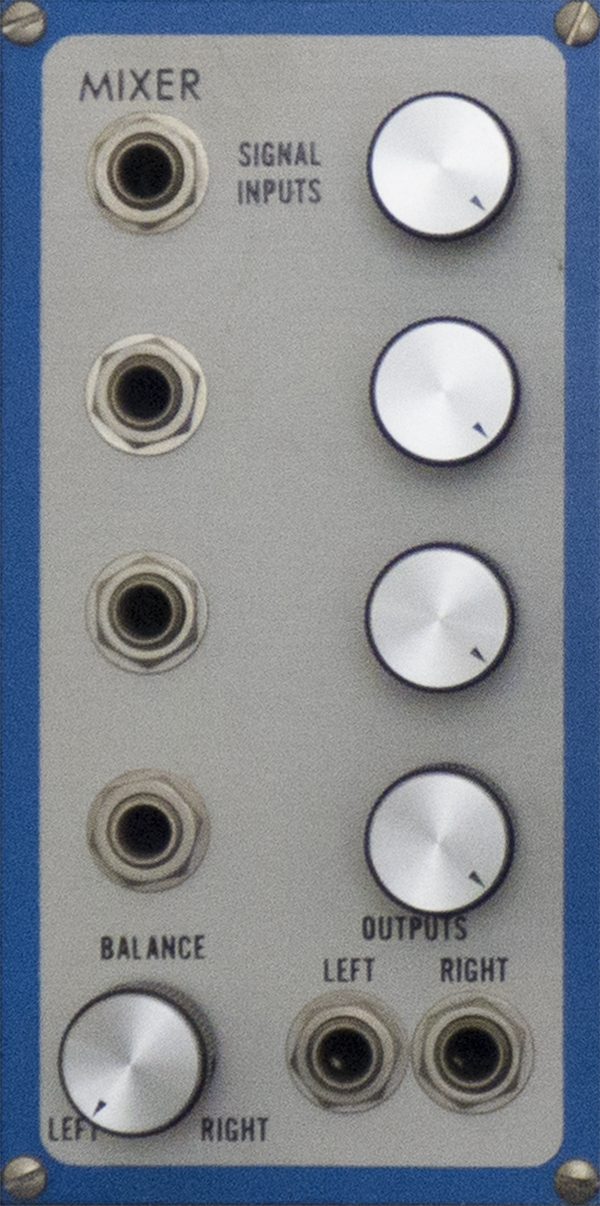 |
Eµ MODULE 2455 - MIXERThe Eµ 2455 Mixer is a four input, stereo output mixer with pan for use within the Eµ modular system. While a mixer is seldom needed in the system as most modules provide input mixing (multiple inputs with attenuators) and output mixing (patching several outputs together in a multiple gives an even mix of the outputs), a dedicated mixer module may prove useful in special situations. The four signal inputs pass through their respective attenuators and are summed to give the mixer output signal. This is then routed into the left and right outputs in a ratio determined by the setting of the balance control. With the balance control fully counterclockwise, the output signal appears unattenuated at the left output jack and no signal appears at the right jack; with the control clockwise, the entire signal is routed instead to the right output jack. At intermediate settings, an appropriate signal level is sent to each jack to simulate spatial positioning, with the total power from the two jacks remaining constant. The balance control could thus be used as a master volume control if only one output were used.
Power Requirements: ±15 V @ 10 mA typical
Firm-wire Patch Connections: Inputs - Signal (4) Outputs - Left & Right (3 pins each) Power Bus Connected Inputs: None Adjustments: None |
Eµ MODULE 2460 - DUAL REVERBThe Eµ 2460 Dual Reverb module is a dual spring type reverberation unit, using an Eµ 1420 submodule. The two channels are completely independent. The input signal to a channel is AC coupled and sent to the reverb spring. The return signal is amplified, and then mixed with the original AC coupled signal, according to the setting of the "% Reverb" control, to produce the final output. The reverb elements are physically separate from the module, and it is recommended that they be placed remote to the synthesizer cabinet to minimize the effects of vibration and hum. If these precautions are taken, the noise and hum are virtually inaudable in normal use.
Power Requirements: ±15 V @ 25 mA typical
Firm-wire Patch Connections: Inputs (2) Outputs (3 pins each) Power Bus Connected Inputs: None Adjustments: None |
THE Eµ MODULAR SEQUENCER
Previously, the only commercially available sequencers have been single function units. By following a modular concept in sequencer design, Eµ Systems has expanded sequencer capabilities in the same way the modular synthesizer surpassed conventional musical instruments. A sequencer is conventionally composed of a clock or time base, a counter, and some sort of voltage selecting and generating device In the modular system, each of these distinct functions is a separate module, which can be interconnected with the others in a variety of ways. The addition of logic function modules further expands the possibilities. Certain common features of the sequencer modules are described below: LOGIC LEVELS - The threshold voltage for logic inputs is nominally 2.5 volts Voltages above 3.5 volts should be considered logical ones, while those below 1.5 volts are logical zeros CLOCK INPUTS - All edge sensitive inputs are independent of risetime, and can consequently be properly driven by any synthesizer waveform. EXTERNAL COMPATIBILITY - Input impedance on all logic inputs is lOOK~. Inputs may be directly driven by CMOS logic, or TTL logic with 4.7K? pull-ups. Naturally, inputs are fully protected from any voltages within the synthesizer. Outputs are directly TTL and CMOS compatible, and short-circuit protected. LOGIC OUTPUTS - Logic one output voltage is +5 volts; logic zero is approximately +0.1 volt. Outputs shorted together through a multiple will "wire-and", meaning that the result will be high only if both signals are high. |
Eµ MODULE 2500 - VOLTAGE CONTROLLED CLOCK
The Eµ 2500 Voltage Controlled Clock module is a low frequency sawtooth/ pulse VCO with special gating capabilities, based on the Eµ 1500 submodule. The initial frequency control varies the clock rate from approximately 0.001 Hz (1 cycle/18 min.) to 500 Hz; the two leftmost frequency modulation inputs vary this center frequency with approximately 1 volt/octave sensitivity. The third FM input has sensitivity adjustable from zero through 1V/octave. The pulse width control varies the pulse duty cycle from virtually zero to virtually 100%. However, a pulse will always be issued each cycle for correct clocking. The pulse width modulation inputs have a maximum sensitivity of 10%/volt. Pulse width modulation is such that only one rising edge can be generated each cycle. The clock may be syncronously gated on or off. When the oscillator is turned off, it will finish the current timing cycle and then stop. When gated back on, a pulse rising edge will immediately be generated. The switch below the lamp determines the function of the on and off input jacks. In the "pulse set" (center) position, a logical one at the "on" input turns the clock on; it may be turned off by a logical one at the "off" input. The "on" lamp is lit when the clock is running. With a logical zero at both inputs, the oscillator stays on or off as set by the most recent pulse. With the switch set in the "on" (upper) position, the clock runs except when a logical one is present at the "off" input (off gating). Similarly, with the switch in the off position, the clock runs only when the on input receives a logical one signal. The pulse output of the clock can be gated to one of two outputs. This gating is also synchrounous in that a pulse will appear at the output which was selected when the clock cycle began. Pulses cannot be cut in half. The output state switch and input jack function is similar to the on/off gating scheme: with the switch in the center position the pulse is sent to the output whose corresponding input jack most recently received a one pulse; with the switch in the upper (1) position, pulses go to output 1 except when input two has a logical one, and vice versa. The functions are illustrated graphically below. The switches are in the "off" and "1" positions respectively.
Power Requirements: ±15 V @ 10 mA typical +5 V @ 50 mA typical
Firm-wire Patch Connections: Frequency Modulation Input Pulse Width Input Outputs (Four, 3 pins each) Power Bus Connected Inputs: None Adjustments: None |
| Eµ MODULE 2510 - 8 POSITION ADDRESS GENERATOR |
MODULE 2520 - VOLTAGE SOURCE OUTPUT UNIT
The Eµ 2510 and 2520 modules perform the basic potentiometer matrix functions of early sequencers. The 2510 is an eight position (3 bit) up/down presetable, cascadable counter; the 2520 is a 4 by 8 potentiometer matrix. The 2510 Address generator is at any time in one of eight position states. The lamp corresponding to this active position will be lit, and the associated position gate output will present a logical one. The binary equivalent of this position (coded 0-7 for positions 1-8) will appear at the binary outputs, the upper being the most significant bit. The binary outputs are usually patched to a 2520 voltage source. A rising edge on the up clock input causes the active state to move right one position, while a pulse on the down clock input will result in a leftward shift. Both clock inputs will be ignored if a logical one is applied to the clock inhibit input. If the position is clocked up from position eight to position one, a pulse will be issued from the carry output. Similarly, clocking down from 1 to 8 will produce a borrow pulse. The carry and borrow outputs could be connected to the up and down clocks of a second 2510 for cascading. Depressing one of the exclusive set pushbuttons will result in shifting the active position to that location regardless of other conditions. Applying a logical one to the appropriate pulse set input will similarly result in exclusively setting that position. The 2520 Voltage Source Output Unit contains four parallel rows of potentiometers. When one of the eight columns is activated (indicated by the corresponding lamp), each of the four outputs will maintain the voltage set by the potentiometer at the row/column intersection. The range of each potentiometer is zero to +10 volts. The selected column is determined by the binary inputs. Columns 1 through 8 will be selected by coded inputs for 0 through 7 respectively, the upper input being the most significant. These inputs will generally be patched to a 2510 address generator. If a logical one appears at the inhibit input, no column will be selected, and all four outputs will go to zero.
Power Requirements: 2510 - +5 V @ 100 mA typical 2520 - +5 V @ 25 mA typical ±15 V @ 25 mA typical
Firm-wire Patch Connections: 2510 - Up and Down Clock Inputs Binary Outputs (3 pins each) Borrow and Carry Outputs (3 pins each) 2520 - Binary Inputs Outputs (Four, 3 pins each) Power Bus Connected Inputs: None Adjustments: None |
Eµ MODULE 2530 - ANALOG SWITCHThe Eµ 2530 Analog Switch is a four channel digitally controlled summing buffer with an additional uncontrolled input for cascading switch sections. The output is the algebraic sum of the voltages appearing at the inputs to activated channels plus the voltage at the unswitched input. Signals at the off inputs are rejected at better than 80 dB. Whenever an input channel is "on", the corresponding lamp is lit. An input channel may be turned on and off in different ways depending on the setting of the three position switch. With the switch in the center (pulse set) position, the channel can be turned on by a logical one pulse at the corresponding "on pulse" input, and turned off by a similar pulse at the "off pulse" input. If both inputs remain at logical zero, the channel stays in the state most recently pulsed. With the switch in the "on" position, the channel will normally be on, and can be gated off by a logical one at the off pulse input. Similarly, with the switch in the off position, a logical one at the "on pulse" input will gate the channel on.
Power Requirements: ±15 V @ 10 mA typical +5 V @ 50 mA typical
Firm-wire Patch Connections: Inputs (4) Output (3 pins) Power Bus Connected Inputs: None Adjustments: None |
Eµ 2540 SERIES - MEMORY SEQUENCER MODULESThe Eµ 2540 Memory Address Generator, 2545 Memory, and 2546 Programmer modules are designed for use together in producing long voltage sequences. The 2540 contains an Eµ 1540 submodule, the 2545 contains a 1545 submodule. The 2540 Memory Address Generator is a 256 (512 optional) position counter. A positive going pulse at the up clock input advances the counter one position; a similar pulse on the down clock input lowers the count. Both inputs are ignored if a logical one is presented to the clock inhibit input. A logical one on the reset input forces the counter to position zero regardless of the status of the other inputs. The up clock pushbutton acts as a fast-forward if held down, but a quick depression will advance the position a single step. The down pushbutton behaves similarly. The reset pushbutton resets the count to zero. The numeric display shows the address position in octal (base 8) notation, which proves particularly useful for conventional music tempos. The count ranges from 000 to 377 octal in the normal version, and to 777 in the extended range unit. Any number of 2545 memories (up to approx. 50) can be driven by a single 2540. For each address position the memory can record an analog voltage and one of four digital codes. The memories are programmed by a common 2546 programmer, which can be controlled by an Eµ keyboard or other voltage source. In fact, it is better to think of the analog data stored in the 2545 memory as key positions rather than as voltages. The upper (1/12 V) analog output on the 2545 reproduces the analog voltage in standard lV/octave tuning, corresponding to the preset interval on a keyboard. The lower output is switchable to be internally preset or to have an interval as determined by the course and fine front panel controls. These are analogous to the interval control on a keyboard. The memory outputs are accurate to 0.1%, although their resolution is only 6 bits (64 states). If greater resolution is required, two memories may be used with their outputs summed, one to provide resolution within the smallest step of the other. The digital outputs are decoded such that only one is high in a given memory location. They may be used to program rests, special emphasis transients, or patch switching, or used as analog voltages to modify sequence timing, etc. Data can be written into the memory when the write enable switch is on (up). A lamp is lit to warn of this condition. By the use of multiple memories and the 2530 Analog Switch module, arbitrarily long sequences can be obtained. The 2546 Programmer can program up to 50 sets of memories through their 2540 address generators. No more than one programmer per address generator may be used. When a rising edge is received by the trigger input, whatever analog voltage is present at the analog input is converted to the nearest keyboard voltage, and stored at the associated address generator position in all write enabled memories. At the same time, whichever digital input is in a logical one state will be written into the digital portion of the memories If all three inputs are at logical zero, the fourth digital code will be written. When a falling edge appears at the gate input, a 10 msec positive pulse is issued from the advance pulse output. The analog input is internally pre-wired to the keyboard 1 control voltage, and the gate input is pre-wired to the keyboard 1 gate output. The trigger input is pre-wired to the gate input (and hence to the keyboard 1 gate when no external gate input is applied). When the advance pulse is patched to a memory address generator up clock, sequential key depressions will cause sequential locations in an enabled memory to be written with the appropriate voltages. The digital codes may be programmed by patching any source of digital information, such as another sequencer module or the low octave gates from a keyboard, into the digital input jacks. When such a patch is not made, the digital input is pre-patched to the switch above it, and will be a logic "1" when the switch is high. (Beware programming with more than one digital input in a logic "1" state; an unexpected code may be programmed.) The digital codes may be programmed simultaneously with the analog voltages, or alternatively in a separate pass through the memory by feeding the l/l2V analog output from the memory into the analog input of the programmer. In the latter case, the programmer will simply write whatever analog data is present in the memory back in, while the digital codes are being reprogrammed. Naturally, the digital codes may similarly be fed back into the programmer to program different analog values independent of the digital bits.
Power Requirements: 2540 - +5 V @ 75 mA typical 2545 - +5 V @ 100 mA typical ±15 V @ 20 mA typical 2546 - +5 V @ 10 mA typical ±15 V @ 25 mA typical
Firm-wire Patch Connections: None
Power Bus Connected Inputs: 2540 - None 2545 - None 2546 - Keyboard 1 Control Voltage Keyboard 1 Gate
Adjustments: 2540 - None 2545 - 1/12V interval Variable interval (Coarse & Fine) 2546 - Interval |
Eµ MODULE 2547 - TAPE INTERFACEThe Eµ 2547 Tape Interface module is a special purpose device provtding permanant non-volatile storage for the contents of Eµ 2545 memory modules on audio recording tape. To record data from a merrory onto tape, the memory's l/12V output should be patched to the programmer's analog input, and the memory's digital outputs 1, 2, & 3 should be patched to the corresponding programmer inputs. The tape interface gate output should be patched to the programmer gate input, and the programmer advance pulse output should be connected to the memory address generator up clock. The "TO TAPE" output should go to the line input for the tape recorder, and the "FROM TAPE" input can be patched to the recorder line output. If less than a full memory is to be recorded, a digital output that goes high on the last address to be sent should be patched to the "STOP" input. If a full memory is used, the 256/512 switch should be set to 256 unless specially modified 512 word memories (consult factory) are to be used. To record data on the tape, set the PGM/RCD switch to RCD, reset the address generator, start the tape, and wait a few seconds for the tape speed to settle. Pressing the "PROCEED" pushbutton initiates data transfer; the contents of a 256 word memory takes 10 seconds. When data transfer is complete, the done lamp will light and the tape can be stopped. If a 3-head tape machine is used, the signal from the playback head may be patched to the "FROM TAPE" input during record mode. In this case, lighting of the "ERROR" lamp indicates a tape flaw has prevented proper recording of data. If the signal at "from tape" was not the playback signal, the error lamp has no meaning. In all cases, errors can be checked by testing the tape in the program mode. To program a memory from tape, the tape interface gate output should be connected to the address generator up clock (patching the gate output to the programmer gate input and the programmer advance pulse output to the up clock will also work). The memory to be programmed should be write enabled, and the PGM/RCD switch should be the PGM position The address generator should be reset before programming. When the tape is started, the "MARK" lamp should light. When the tape speed has settled, and the mark lamp does not flicker, the proceed pushbutton should be pressed. After the data stream has finished, the done lamp will light and the memory will be programmed. If the error lamp is also lit, one or more words in the memory may be misprogrammed. When they have been found and corrected a new tape should be made. The 2547 disables the normal operation of the programmer when the PGM/RCD switch is in PGM, hence this switch should always be returned to RCD for normal system use. The specifications required of the tape recorder are fairly lenient; it is only necessary that the long term speed variation be less than ˜5%. The recording tape should be selected primarily for low dropout. We have had good results using TDK tape on an ordinary cassette machine.
Power Requirements: ±15 V @ 30 mA typical +5 V @ 60 mA typical
Firm-wire Patch Connections: None Power Bus Connected Inputs: None Adjustments: Mark Frequency Space Frequency PLL Center Frequency Clock Frequency |
Eµ 2550 SERIES - LOGIC MODULESThe Eµ 2550 Series Logic Modules perform elementary logic functions for use with 2500 series sequencer modules. The 2550 Hex Digital Inverter module has six identical logically inverting stages. If a logical zero is present at the input of an inverter, its output will be at +5 volts, while a logical one at the input will take the output near ground (+0.1 volt). The 2551 Triple Or Gate module performs the logical "or" function on two or three inputs. In each section the output will be a logical one if any of the corresponding inputs are at a logical one. The 2552 Triple Latch module contains three identical digital "sample and hold" circuits. When the clock input changes from logical zero to logical one, whatever digital value was at the data input during the transition will appear at the Q output, and its complement will appear at Q. The data input is internally prewired to the Q output, so that if no data input patch is present, the stage acts as a divide-by-two circuit when a square wave is applied to the clock input. The 2553 Dual One-Shot module contains two pulse-forming circuits. When a rising edge appears at the input, a pulse of duration as set by the pulse width control (10 msec - 10 sec.) will occur at the output. The circuit is nonretriggerable, and is particularly useful in transforming audio signals into digital clock pulses.
Power Requirements: 2550 - +5 V @ 40 mA typical 2551 - +5 V @ 20 mA typical 2552 - +5 V @ 50 mA typical 2553 - +5 V @ 25 mA typical |
Eµ 2905 SERIES - POWER SUPPLIESThe Eµ 2905 Power Supply Modules are complete power systems for Eµ modular synthesizers. The 2905's front panel contains the power switch and pilot lamp, plus multiple outputs for two keyboards. When a keyboard is not connected, the associated system busses can be used for routing any signal by applying via these power supply panel jacks. The interface panel (on cabinet rear) holds the power cord connector, fuse, and connectors for the two keyboards. In addition, four general purpose 24 pin connectors are provided. These can be used for custom functions, multi-voiced keyboard connections, or inter-cabinet firm-wiring. The power supplies are current limited, overvoltage and reverse voltage protected, and factory calibrated. One 2905 module is required per cabinet. The Eµ 2906 multiple panel consists of eight four-wide multiples. The Eµ 1905 Power Supply submodule consists of the power supply circuit board for the 2905 module, less connectors used for our power distribution system. Transformers are included. The 1905 is recommended for submodule users who want a well protected, reliable supply.
Power Requirements: Input 100-140 VAC 50-60 Hz Output ±15V @ 1.5A +5V ±5% @ 1.0A
Firm-wire Patch Connections: Keyboard 1 & 2 CV, Gate & Trigger (6 outpute, 3 pins each)
Power Bus Connected Inputs: Keyboards 1 & 2 CV, Gate & Trigger
Adjustments: +15V output -15V/+15V ratio |
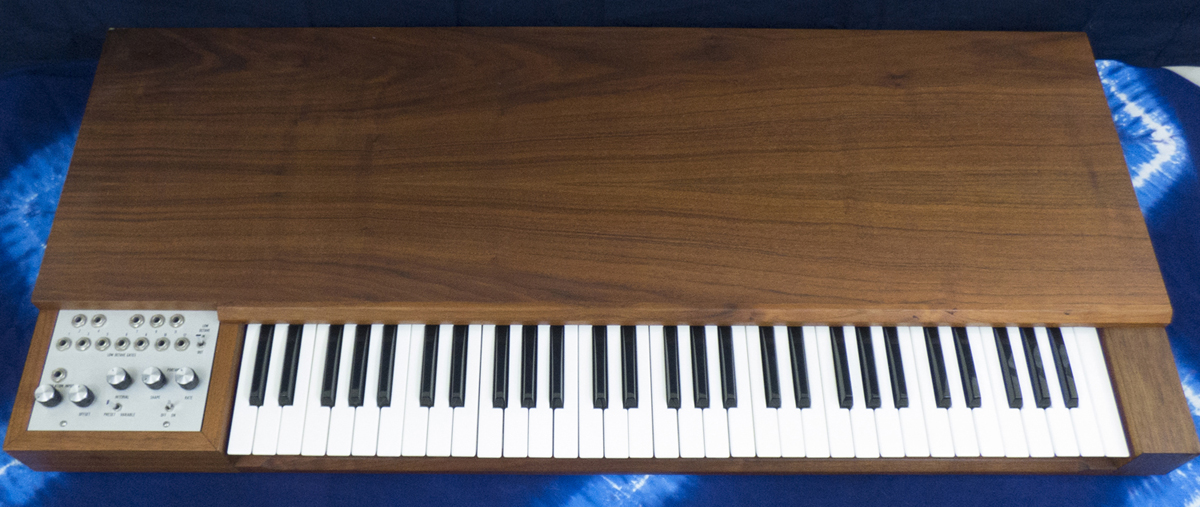 |
Eµ 4000 SERIES - MONOPHONIC KEYBOARDSThe Eµ 4000 series keyboards represent a major advance in synthesizer technology. Unreliable spring-type contacts have been replaced by J-wires, and finiky analog circuits have been superceded by a stable digital design. The result is an accurate voice output, timing signals that give attacks at the right times, and the addition of several new features. The voice output is a voltage proportional to the lowest key pressed, or the last key to be depressed when all are released. It is totally drift-free, and accurate to 1/24 semitone. The constant of proportionality (interval) is linearly variable from zero to over two volts per octave, and can be instantly preset to lV/octave. The gate output is high whenever any key is depressed. The trigger output, a 100 ~sec pulse which initiates new attacks on transient generators, fires whenever the gate rises, or when the voice changes notes. Internal circuitry totally eliminates the effects of contact bounce on all outputs. The portamento circuit produces a glide between notes, whose shape is variable from linear (control fully counterclockwise) to exponential. The rate control varies the initial glide slope from lV/10 msec to lV/sec. With the portamento switch off, the slew rate is in excess of a volt per microsecond. The low octave gates are a set of twelve signals, each of which is high when the corresponding key in the low octave is depressed, and low when it is released. The low octave may be switched off so these gates can be used without affecting the voice or timing signals. The offset control adds or subtracts 0.2 volts (about 2 semitones) from the control voltage output of the keyboard. A voltage applied to the modulation input is added to the keyboard output voltage before processing by the portamento circuit. The gain is determined by the attenuator below the input, and can be varied from zero to O.lV/V.
POWER CONNECTOR PIN ASSIGNMENTS: Pin 1 - +15V Pin 4 - -15V Pin 7 - Cnt'l V Pin 10 - NC Pin 2 - GND Pin 5 - +5V Pin 8 - Gate Pin 11 - NC Pin 3 - GND Pin 6 - +5V Pin 9 - Trigger Pin 12 - NC
POWER REQUIREMENTS: ±15 V @ 25 mA typical +5 V @ 75 mA typical
ADJUSTMENTS: V/octave (adjustable through hole in bottom of cabinet)
ORDERING INFORMATION: 4000 - Monophonic Keyboard in walnut cabinet 4003 - Monophonic Keyboard Circuit Board, exclusive of panel controls and keyboard manual, fully tested. |
THANKS FOR THE INFORMATION TO THE FOLLOWING Riley Smith- Source of large amounts of scans. Ed Rudnick for being Ed. Gary, Jeff, Gunnar, and Mike at the bird for the technical assistance. of course CEO of Parts Mr.Mike, and the man Dave Rossum. |
Silicon Breakdown has been a source of free information and pictures for analog synthesizers since 1999
The Music side of this site contains the sounds of Silicon Breakdown and various other musical adventures. MUSIC HERE
The Synth side showcases beautiful instruments from the past. ANALOG SYNTHESIZER INFO HERE
send comments to james AT siliconbreakdown.com (replace AT with @)



